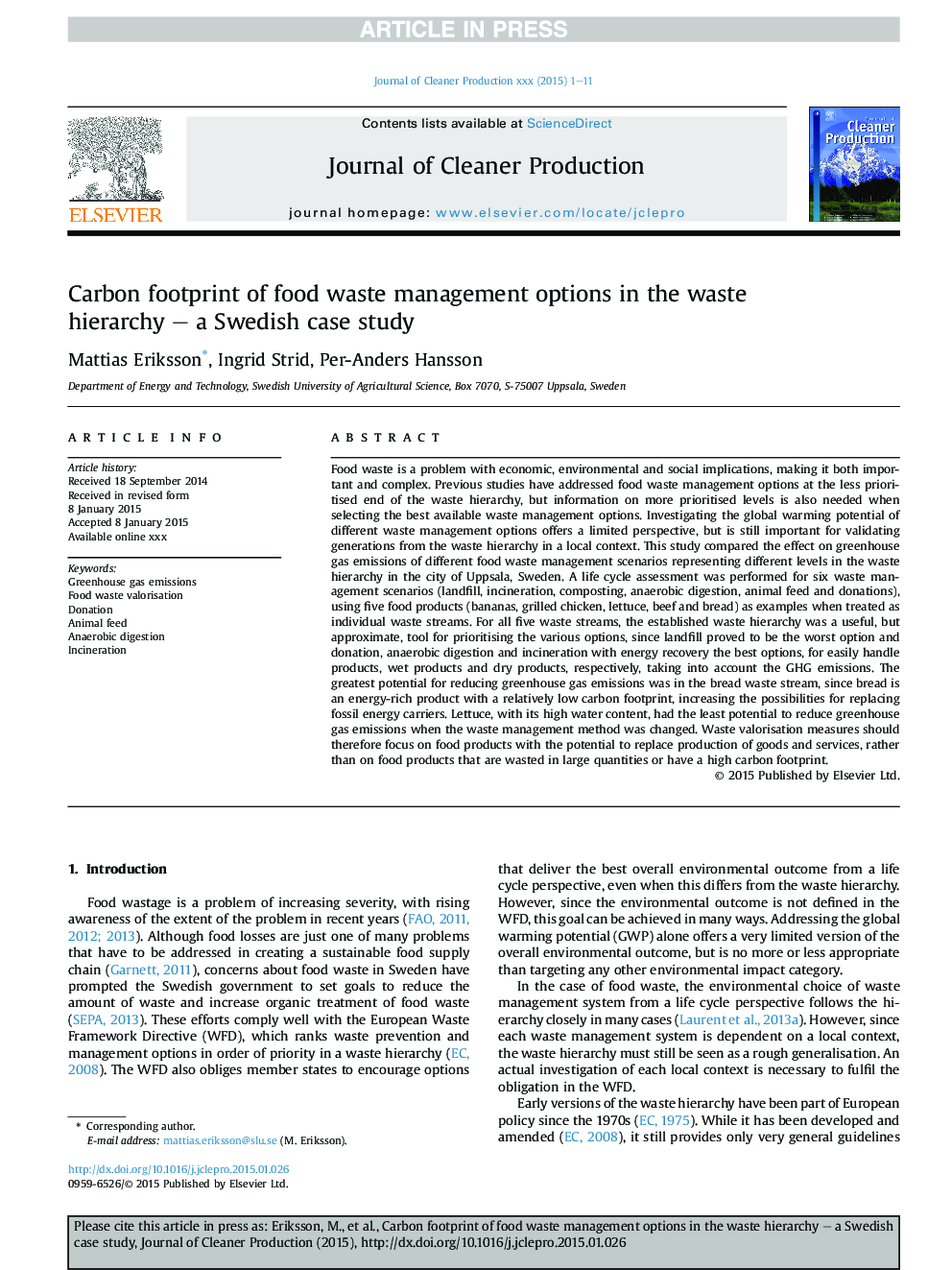| کد مقاله | کد نشریه | سال انتشار | مقاله انگلیسی | نسخه تمام متن |
|---|---|---|---|---|
| 8104757 | 1522153 | 2015 | 11 صفحه PDF | دانلود رایگان |
عنوان انگلیسی مقاله ISI
Carbon footprint of food waste management options in the waste hierarchy - a Swedish case study
ترجمه فارسی عنوان
راندمان کربن از گزینه های مدیریت زباله های مواد غذایی در سلسله مراتب زباله - یک مطالعه مورد سوئدی
دانلود مقاله + سفارش ترجمه
دانلود مقاله ISI انگلیسی
رایگان برای ایرانیان
کلمات کلیدی
انتشار گازهای گلخانه ای، غلظت مواد زائد مواد غذایی، کمک مالی، خوراک دام، هضم بی هوازی سوزاندن،
ترجمه چکیده
زباله های مواد غذایی مشکلی با مفاهیم اقتصادی، زیست محیطی و اجتماعی دارند، و آن را مهم و پیچیده می کند. در مطالعات قبلی، گزینه های مدیریت زباله های مواد غذایی را در انتهای سلسله مراتب زباله ها کم اهمیت تر قرار داده اند، اما در هنگام انتخاب بهترین گزینه های مدیریت زباله، اطلاعات در مورد سطوح اولویت بیشتر نیز مورد نیاز است. بررسی پتانسیل گرم شدن کره زمین از گزینه های مختلف مدیریت زباله ارائه می دهد چشم انداز محدود، اما هنوز هم برای معتبر نسل ها از سلسله مراتب زباله در یک زمینه محلی مهم است. در این مطالعه، اثر بر انتشار گازهای گلخانه ای از سناریوهای مختلف مدیریت پسماند مواد، نشان دهنده سطوح مختلف در سلسله مراتب زباله در شهر اوپسالا، سوئد است. یک ارزیابی چرخه عمر برای شش سناریو مدیریت زباله (دفن زباله، دفع زباله، کمپوست، هضم بی هوازی، خوراک دام و اهدای خون)، با استفاده از پنج محصول غذایی (موز، مرغ کبابی، کاهو، گوشت گاو و نان) به عنوان نمونه هایی که به عنوان زباله های فردی جریان ها برای هر پنج جریان زباله، سلسله مراتب تاسیسات زدایی، یک ابزار مفیدی بود اما برای تقسیم کردن گزینه های مختلف، از آنجا که دفع زباله ها بدترین گزینه بود و اهدای، هضم بی هوازی و سوزاندن با بازیابی انرژی بهترین گزینه ها برای راحتی رسیدگی به محصولات ، محصولات مرطوب و محصولات خشک، به ترتیب با توجه به انتشار گازهای گلخانه ای. بزرگترین پتانسیل برای کاهش انتشار گازهای گلخانه ای در جریان جریان نان بود زیرا نان یک محصول با غنی از انرژی با رد پای کربن نسبتا کم است و امکان جایگزینی نانوساختارهای فسیلی را افزایش می دهد. کاشت، با محتوای آب بالا، دارای حداقل توانایی کاهش انتشار گازهای گلخانه ای بود که روش مدیریت زباله تغییر یافت. بنابراین اقدامات ارزشمندی زباله باید بر روی محصولات غذایی با جایگزینی برای تولید کالاها و خدمات تمرکز کند، نه به محصولات غذایی که در مقادیر زیادی هدر می رود و یا دارای رد پای کربن هستند.
موضوعات مرتبط
مهندسی و علوم پایه
مهندسی انرژی
انرژی های تجدید پذیر، توسعه پایدار و محیط زیست
چکیده انگلیسی
Food waste is a problem with economic, environmental and social implications, making it both important and complex. Previous studies have addressed food waste management options at the less prioritised end of the waste hierarchy, but information on more prioritised levels is also needed when selecting the best available waste management options. Investigating the global warming potential of different waste management options offers a limited perspective, but is still important for validating generations from the waste hierarchy in a local context. This study compared the effect on greenhouse gas emissions of different food waste management scenarios representing different levels in the waste hierarchy in the city of Uppsala, Sweden. A life cycle assessment was performed for six waste management scenarios (landfill, incineration, composting, anaerobic digestion, animal feed and donations), using five food products (bananas, grilled chicken, lettuce, beef and bread) as examples when treated as individual waste streams. For all five waste streams, the established waste hierarchy was a useful, but approximate, tool for prioritising the various options, since landfill proved to be the worst option and donation, anaerobic digestion and incineration with energy recovery the best options, for easily handle products, wet products and dry products, respectively, taking into account the GHG emissions. The greatest potential for reducing greenhouse gas emissions was in the bread waste stream, since bread is an energy-rich product with a relatively low carbon footprint, increasing the possibilities for replacing fossil energy carriers. Lettuce, with its high water content, had the least potential to reduce greenhouse gas emissions when the waste management method was changed. Waste valorisation measures should therefore focus on food products with the potential to replace production of goods and services, rather than on food products that are wasted in large quantities or have a high carbon footprint.
ناشر
Database: Elsevier - ScienceDirect (ساینس دایرکت)
Journal: Journal of Cleaner Production - Volume 93, 15 April 2015, Pages 115-125
Journal: Journal of Cleaner Production - Volume 93, 15 April 2015, Pages 115-125
نویسندگان
Mattias Eriksson, Ingrid Strid, Per-Anders Hansson,
